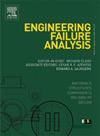Stiffness degradation failure mechanisms and probabilistic fatigue life analysis of TA1 clinched joints
IF 4.4
2区 工程技术
Q1 ENGINEERING, MECHANICAL
引用次数: 0
Abstract
Lightweight connections present a challenging task in engineering, requiring assurance of reliability, safety, and adaptability. Additionally, the fatigue failure behavior and lifespan distribution of the connection structure must be considered. Therefore, it is essential to develop fatigue life prediction models. This study aims to advance the application of clinched joint technology in practical engineering by conducting fatigue tests on TA1 titanium alloy clinched joints at different stress levels. An in-depth analysis of the relationship between joint displacement, stiffness, and failure behavior revealed the fatigue failure mechanisms of the joint. Probability fatigue life curves were constructed based on four statistical models, and their performance was evaluated. The results show that the primary failure mode of TA1 titanium alloy clinched joints is fracture of the lower plate. As the number of cycles increased, both the failure displacement and extent of damage grew. Stiffness degradation curves show three different stages of fatigue failure and their failure mechanisms are analyzed. Furthermore, it is recommended to use the Gumbel model for fatigue life design, as it provides sufficient constraints on fatigue data with small sample sizes, making it well-suited for practical engineering applications.

TA1铰接刚度退化失效机理及概率疲劳寿命分析
轻量化连接在工程中是一项具有挑战性的任务,需要保证可靠性、安全性和适应性。此外,还必须考虑连接结构的疲劳破坏行为和寿命分布。因此,建立疲劳寿命预测模型是十分必要的。本研究通过对TA1钛合金在不同应力水平下的铰接接头进行疲劳试验,以推进铰接技术在实际工程中的应用。深入分析了关节位移、刚度和破坏行为之间的关系,揭示了关节的疲劳破坏机制。基于四种统计模型构建了概率疲劳寿命曲线,并对其性能进行了评价。结果表明:TA1钛合金压紧接头的主要失效模式为下板断裂;随着循环次数的增加,破坏位移和破坏程度都在增加。刚度退化曲线显示了疲劳破坏的三个不同阶段,并分析了它们的破坏机理。此外,建议使用Gumbel模型进行疲劳寿命设计,因为它在小样本量下提供了足够的疲劳数据约束,使其非常适合实际工程应用。
本文章由计算机程序翻译,如有差异,请以英文原文为准。
求助全文
约1分钟内获得全文
求助全文
来源期刊

Engineering Failure Analysis
工程技术-材料科学:表征与测试
CiteScore
7.70
自引率
20.00%
发文量
956
审稿时长
47 days
期刊介绍:
Engineering Failure Analysis publishes research papers describing the analysis of engineering failures and related studies.
Papers relating to the structure, properties and behaviour of engineering materials are encouraged, particularly those which also involve the detailed application of materials parameters to problems in engineering structures, components and design. In addition to the area of materials engineering, the interacting fields of mechanical, manufacturing, aeronautical, civil, chemical, corrosion and design engineering are considered relevant. Activity should be directed at analysing engineering failures and carrying out research to help reduce the incidences of failures and to extend the operating horizons of engineering materials.
Emphasis is placed on the mechanical properties of materials and their behaviour when influenced by structure, process and environment. Metallic, polymeric, ceramic and natural materials are all included and the application of these materials to real engineering situations should be emphasised. The use of a case-study based approach is also encouraged.
Engineering Failure Analysis provides essential reference material and critical feedback into the design process thereby contributing to the prevention of engineering failures in the future. All submissions will be subject to peer review from leading experts in the field.
 求助内容:
求助内容: 应助结果提醒方式:
应助结果提醒方式:


